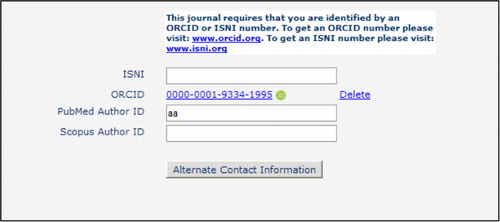There has been increasing interest in the scholarly community in a consistent method by which to identify oneself and one's research. This has arisen due to the pressing need to definitively identify individuals and successfully distinguish them from others with similar names, for example:
Make a distinction between John Smith working at Institute X and John Smith working at Institute Y.
Demonstrating that John Smith is the same individual as J. Smith.
Linking Sarah Jones to research completed under her maiden name, Sarah Brown.
To quote ORCID's own Mission webpage:
ORCID aims to solve the name ambiguity problem in research and scholarly communications by creating a central registry of unique identifiers for individual researchers and an open and transparent linking mechanism between ORCID and other current researcher ID schemes. These identifiers, and the relationships among them, can be linked to the researcher's output to enhance the scientific discovery process and to improve the efficiency of research funding and collaboration within the research community. (http://orcid.org/content/mission-statement)
ORCID is free of charge to authors and anyone can obtain an ORCID identifier from the ORCID website. Some institutions have also collaborated with ORCID to register their researchers en masse, to enable accurate tracking of institutional research output.
ScholarOne Manuscripts and Editorial Manager have recently released functionality that allows authors to search for their ORCID, uniformly link it to their accounts and their accepted submissions. This system interconnectivity is a major step forward for ORCID, manuscript submission systems, and, by extension, content platforms like Taylor & Francis Online. Linking ORCIDs to submissions at the point a manuscript submission record is created ensures that the researcher and the work are indelibly linked in the version of record.
This linking of researchers to published research is not only of benefit to authors themselves; the addition of an ORCID to a peer review system account also enables Editors to evaluate potential reviewers’ ORCID profiles, a useful tool to assist verification of credentials and assess suitability for particular review assignments.
Editorial Manager provides person authentication functionality by linking with ORCID's database. When creating or editing user accounts on Editorial Manager, users may enter their ORCID number if they have one. The “Fetch” link beside the ORCID field navigates to the ORCID site, where users can confirm that their Editorial Manager user account should be linked to their ORCID identifier. Once verified, a green “ID” marker ![]() will appear next to the ORCID number (now a hyperlink) in their account details (see ), confirming that the ORCID has successfully linked. If the user does not have an ORCID already, the link next to and also above the ORCID field links users to the online registration forms where they may apply for one.
will appear next to the ORCID number (now a hyperlink) in their account details (see ), confirming that the ORCID has successfully linked. If the user does not have an ORCID already, the link next to and also above the ORCID field links users to the online registration forms where they may apply for one.
Administrators on Editorial Manager sites also have the option of using the same “Fetch” link to check an individual's ORCID identifier, searching the ORCID database to see if a record exists matching that individual's name. Administrators cannot “Verify” the account – only the individual/ORCID account holder can do that – but it is a useful tool for administrators and Editors to prevent cases of mistaken identity.
Like Editorial Manager, ScholarOne Manuscripts provides a field on account creation that gives users the option of entering their ORCID identifier. The v4.14 update of ScholarOne Manuscripts, released on 9 December 2013, will see verification functionality which allows users to create an ORCID account and then authenticate it from within ScholarOne Manuscripts. As with Editorial Manager, once an ORCID is authenticated in ScholarOne Manuscripts, a “Verified” marker will appear alongside their account.
By integrating ORCID with these key peer-review system workflows, journals have an accurate record of user accounts that verifiably “belong to” the individual in question. This is useful not only for authors to record their submitted papers, but also for researchers to record and link their involvement in various other research activities, allowing it to be clearly understood that the author of Paper X, the Editor of Journal Y and the board member of Journal Z are all the same individual.
In establishing a registry of unique identifiers in which individuals and organisations can manage and maintain a record of activities, ORCID provides two core functions in addressing the increasing interest in reliable, consistent identification of individuals and their professional activities in the scholarly community and supporting integration with peer-review systems, even so far as providing authentication functionality. These two key features go a long way towards both the consistent identification of individuals and also combatting the potential issue of identity appropriation in cases of misconduct.
We are currently working out how best to incorporate ORCID information into our journals platform, Taylor & Francis Online, and will communicate our plans in due course.
Additional information
Notes on contributors

Lucy Francis
Lucy Francis joined Taylor & Francis in March 2012. She currently works on the In-House Peer Review Team as a Peer Review Co-ordinator, supporting Editors and assisting authors and reviewers for four in-house titles. Lucy also provides support for the Journal Editorial Office of 10 further journals and is involved with training external Editors in the use of CrossCheck similarity-identification software.
